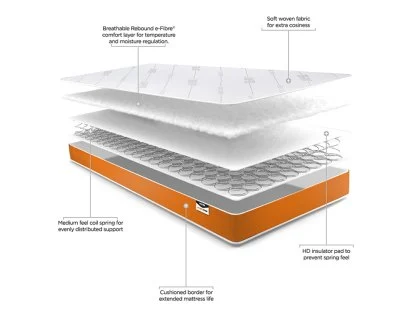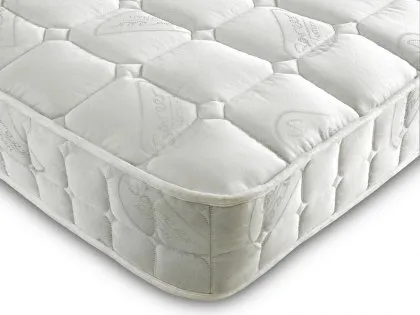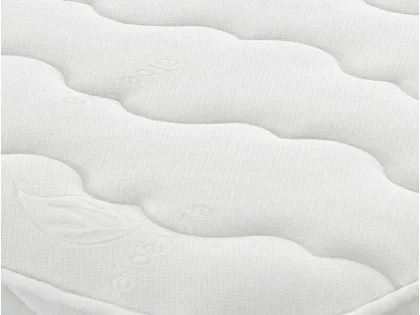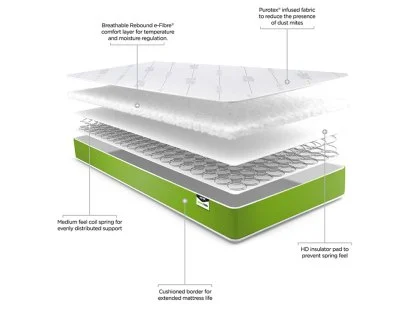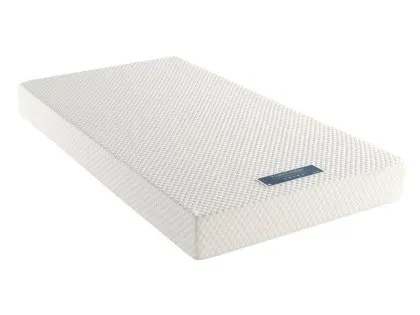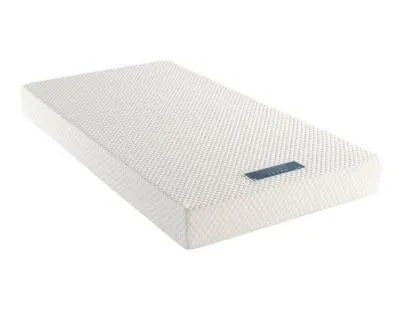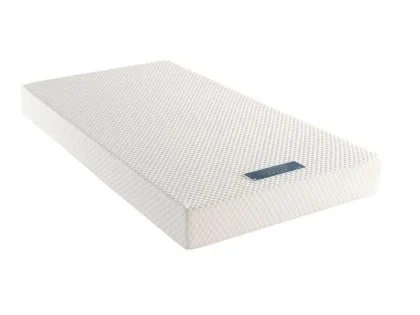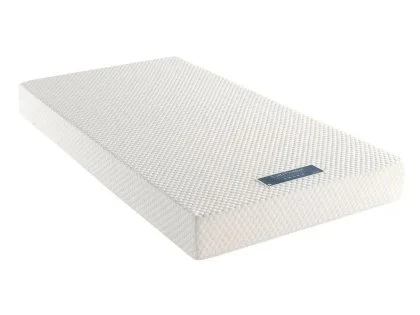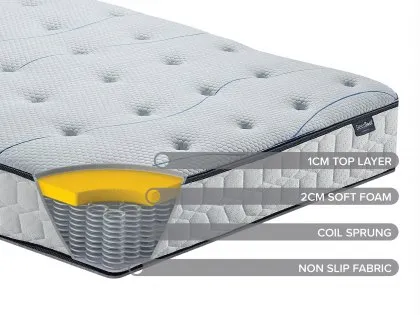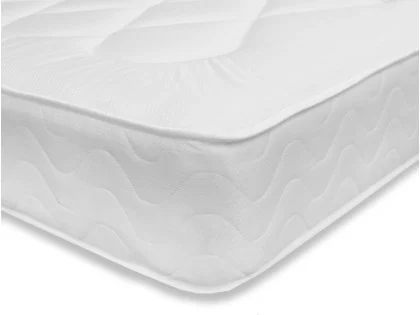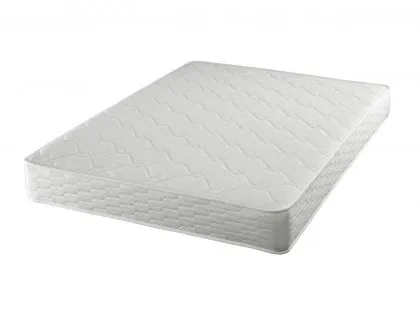For a great night’s sleep, our collection features a variety of reflex foam mattresses, single memory foam mattresses and single pocket sprung mattresses.
Medium
Supporting and contouring your body shape, it’s ideal for those who switch from sleeping on their side, to sleeping on their backOpen Coil
An interconnected spring system that is extremely robust and durableSingle Sided
Mattress Depth
The mattress depth is taken from the highest point to the lowest point.Soft to Medium
A gentle and supportive sleeping surface that moulds to your body shape. Ideal for those who prefer to sleep on their sideOpen Coil
An interconnected spring system that is extremely robust and durableDouble Sided
Mattress Depth
The mattress depth is taken from the highest point to the lowest point.Soft to Medium
A gentle and supportive sleeping surface that moulds to your body shape. Ideal for those who prefer to sleep on their sideFoam
A durable lightweight alternative to springs that offers edge to edge support maximising the sleeping areaMemory Foam
Body moulding and pressure relieving material designed to reduce tossing and turning for a more restful night's sleepSingle Sided
Mattress Depth
The mattress depth is taken from the highest point to the lowest point.Medium
Supporting and contouring your body shape, it’s ideal for those who switch from sleeping on their side, to sleeping on their backOpen Coil
An interconnected spring system that is extremely robust and durableDouble Sided
Mattress Depth
The mattress depth is taken from the highest point to the lowest point.Medium
Supporting and contouring your body shape, it’s ideal for those who switch from sleeping on their side, to sleeping on their backOpen Coil
An interconnected spring system that is extremely robust and durableSingle Sided
Mattress Depth
The mattress depth is taken from the highest point to the lowest point.Medium
Supporting and contouring your body shape, it’s ideal for those who switch from sleeping on their side, to sleeping on their backOpen Coil
An interconnected spring system that is extremely robust and durableMemory Foam
Body moulding and pressure relieving material designed to reduce tossing and turning for a more restful night's sleepSingle Sided
Mattress Depth
The mattress depth is taken from the highest point to the lowest point.Medium
Supporting and contouring your body shape, it’s ideal for those who switch from sleeping on their side, to sleeping on their backFoam
A durable lightweight alternative to springs that offers edge to edge support maximising the sleeping areaSingle Sided
Mattress Depth
The mattress depth is taken from the highest point to the lowest point.Medium to Firm
A suitable level of support for those who can’t choose between medium and firm, but want a comfortable mattress that’s not too hardFoam
A durable lightweight alternative to springs that offers edge to edge support maximising the sleeping areaSingle Sided
Mattress Depth
The mattress depth is taken from the highest point to the lowest point.Medium to Firm
A suitable level of support for those who can’t choose between medium and firm, but want a comfortable mattress that’s not too hardFoam
A durable lightweight alternative to springs that offers edge to edge support maximising the sleeping areaSingle Sided
Mattress Depth
The mattress depth is taken from the highest point to the lowest point.Medium
Supporting and contouring your body shape, it’s ideal for those who switch from sleeping on their side, to sleeping on their backFoam
A durable lightweight alternative to springs that offers edge to edge support maximising the sleeping areaSingle Sided
Mattress Depth
The mattress depth is taken from the highest point to the lowest point.Firm
An ideal choice if you require a higher level of support. A firm mattress will suit those who prefer to sleep on their back or frontOpen Coil
An interconnected spring system that is extremely robust and durableMemory Foam
Body moulding and pressure relieving material designed to reduce tossing and turning for a more restful night's sleepSingle Sided
Mattress Depth
The mattress depth is taken from the highest point to the lowest point.Medium to Firm
A suitable level of support for those who can’t choose between medium and firm, but want a comfortable mattress that’s not too hardOpen Coil
An interconnected spring system that is extremely robust and durableDouble Sided
Mattress Depth
The mattress depth is taken from the highest point to the lowest point.Firm
An ideal choice if you require a higher level of support. A firm mattress will suit those who prefer to sleep on their back or frontOpen Coil
An interconnected spring system that is extremely robust and durableSingle Sided
Mattress Depth
The mattress depth is taken from the highest point to the lowest point.Soft to Medium
A gentle and supportive sleeping surface that moulds to your body shape. Ideal for those who prefer to sleep on their sideOpen Coil
An interconnected spring system that is extremely robust and durableSingle Sided
Mattress Depth
The mattress depth is taken from the highest point to the lowest point.Medium
Supporting and contouring your body shape, it’s ideal for those who switch from sleeping on their side, to sleeping on their backFoam
A durable lightweight alternative to springs that offers edge to edge support maximising the sleeping areaSingle Sided
Mattress Depth
The mattress depth is taken from the highest point to the lowest point.Firm
An ideal choice if you require a higher level of support. A firm mattress will suit those who prefer to sleep on their back or frontPocket Springs
Pocket springs are individual independent springs that contour to your bodyshape and minimise partner disturbanceDouble Sided
Mattress Depth
The mattress depth is taken from the highest point to the lowest point.Soft to Medium
A gentle and supportive sleeping surface that moulds to your body shape. Ideal for those who prefer to sleep on their sideFoam
A durable lightweight alternative to springs that offers edge to edge support maximising the sleeping areaDouble Sided
Mattress Depth
The mattress depth is taken from the highest point to the lowest point.Extra Firm
Orthopaedic style mattresses are designed to care for those who suffer from back pain by offering enhanced levels of supportOpen Coil
An interconnected spring system that is extremely robust and durableDouble Sided
Mattress Depth
The mattress depth is taken from the highest point to the lowest point.Medium
Supporting and contouring your body shape, it’s ideal for those who switch from sleeping on their side, to sleeping on their backFoam
A durable lightweight alternative to springs that offers edge to edge support maximising the sleeping areaMemory Foam
Body moulding and pressure relieving material designed to reduce tossing and turning for a more restful night's sleepSingle Sided
Mattress Depth
The mattress depth is taken from the highest point to the lowest point.Medium to Firm
A suitable level of support for those who can’t choose between medium and firm, but want a comfortable mattress that’s not too hardOpen Coil
An interconnected spring system that is extremely robust and durableDouble Sided
Mattress Depth
The mattress depth is taken from the highest point to the lowest point.Medium to Firm
A suitable level of support for those who can’t choose between medium and firm, but want a comfortable mattress that’s not too hardFoam
A durable lightweight alternative to springs that offers edge to edge support maximising the sleeping areaMemory Foam
Body moulding and pressure relieving material designed to reduce tossing and turning for a more restful night's sleepSingle Sided
Mattress Depth
The mattress depth is taken from the highest point to the lowest point.Medium
Supporting and contouring your body shape, it’s ideal for those who switch from sleeping on their side, to sleeping on their backOpen Coil
An interconnected spring system that is extremely robust and durableSingle Sided
Mattress Depth
The mattress depth is taken from the highest point to the lowest point.Medium to Firm
A suitable level of support for those who can’t choose between medium and firm, but want a comfortable mattress that’s not too hardOpen Coil
An interconnected spring system that is extremely robust and durableMemory Foam
Body moulding and pressure relieving material designed to reduce tossing and turning for a more restful night's sleepSingle Sided
Mattress Depth
The mattress depth is taken from the highest point to the lowest point.Medium
Supporting and contouring your body shape, it’s ideal for those who switch from sleeping on their side, to sleeping on their backPocket Springs
Pocket springs are individual independent springs that contour to your bodyshape and minimise partner disturbanceMemory Foam
Body moulding and pressure relieving material designed to reduce tossing and turning for a more restful night's sleepSingle Sided
Mattress Depth
The mattress depth is taken from the highest point to the lowest point.What size is a single mattress?
The regular single bed mattress is 3ft wide (90cm) and 6ft3 long (190 cm). Many people often choose this type of mattress for a child's or teenager's room.
What is the smallest size mattress you can buy?
Standard size mattresses start at 2ft6 x 6ft3 for a small single, you can obtain unique size mattresses to accommodate a compact bedroom.
Are small single and single mattresses the same size?
Both single mattresses are 6ft3 long, but small single bed mattresses are only 2ft6 (75cm wide), compared to a standard single mattress at 3ft (90cm) wide.
How much should I spend on a new single mattress?
You should spend as much as you are comfortable with, but bear in mind, the more you spend, the better the quality support and comfort your single mattress will offer, resulting in a great night’s sleep.
Can I buy a cheap single mattress?
If you are working to a budget, you can buy a cheap single mattress, but it won't offer the same benefits and quality that mid to high end mattresses will provide.
How long does a single mattress last?
Just like a complete single divan bed, the average lifespan of a single bed mattresses is between 8 and 10 years, but various factors can affect its lifespan. The construction, materials, weight, and sleeping habits can impact the support, comfort, and durability of a bed. These factors determine how well the bed supports the body, how comfortable it feels, and how long it will last. To make your mattress last longer, keep it clean and well-ventilated. The most important thing is to regularly rotate and flip it over.
Is a 20-year-old single mattress still good?
No. A mattress usually lasts 8-10 years. It's unlikely that such an old mattress will still be supportive and allow you to sleep comfortably. We spend an average of 8 hours a night in bed, so over a 10-year period will amount to 20200 hours of wear and tear.
Is sleeping on an old mattress unhealthy?
Mattresses over 10 years old have lots of bacteria, including staphylococcus, enterococcus, norovirus, and sometimes MRSA. They can all lead to skin infections, urinary tract infections and other serious viruses. Old mattresses can be dangerous if there is mould, especially in a poorly ventilated and damp bedroom.
What are the signs of an old mattress?
When a mattress sags and lacks support, it is no longer good. This can cause you to wake up with aches and pains. If your mattress is uncomfortable or lumpy, you may not realise it, but it can affect your sleep quality.
Is choosing the correct firmness rating important?
When buying a new single bed, it's important to consider the firmness rating of the mattress you prefer. If you sleep on your side, choose a single pocket sprung mattress with soft to medium support. If you change positions at night, a medium firm single mattress is best for you. Medium firm is renowned for providing the extra support that your spine, neck and lower back require.
Sleeping in a natural position helps to keep your spine aligned, resulting in a good night's sleep. If you sleep on your front or back, choose a firm or extra firm mattress with extra support.
Firmer mattresses are also the best single mattress option for heavier people who require an extra firm mattress for additional support.
What single mattresses are available?
We offer a variety of single mattresses. These include cheap foam mattresses, pocket sprung mattresses that conform to your body, and single memory foam mattresses.
Reflex Foam is a very supportive, hypo-allergenic material that is extremely long lasting and comfortable.
Open Coil are traditional spring systems made of rows of hourglass shaped springs connected by spiral wires at the top and bottom. They are strong and long-lasting.
Continuous Coil is a unique type of spring system that consists of intertwining coils running the length of the mattress. This reduces roll-together and partner disturbance.
Pocket Spring - Each spring is in its own pocket, fitting your body shape and reducing partner disturbance for excellent support.
What fillings does a single mattress use?
Polyester is a synthetic and budget material that is renowned for its durability, breathability and hypoallergenic properties.
Natural materials like wool, cotton, cashmere, and silk regulate body temperature, keeping you cool in summer and warm in winter.
Memory foam reacts to body heat, softens and contours to your body, reducing tossing and turning for better sleep.
Gel foam is a material that is breathable, instantly responsive, and helps relieve pressure and remove excess body heat.
Latex is hypo-allergenic, elastic, regulates temperature and moisture, and provides great comfort and support for sleepers.
What fabrics do single mattresses use?
Stitchbond Cover- This is the lowest grade of fabric covering used to upholster mattresses. Most people use it on budget and cheap single mattresses.
Damask fabric is strong and long-lasting with a classic woven pattern. It feels soft, allows air to pass through, and is flexible for a cozy sleep.
Soft stretch knit fabric moulds to your body shape for maximum comfort and support.
Viscose Cover - A premium fabric that is soft to the touch, breathable and renowned for its attractive silk-like lustre.
Cotton is a tough fabric that works well in any weather. It keeps you cool in summer and warm in winter.
Soft teddy bear fabric for a comfortable and luxurious mattress top panel.
Coolmax Fabric - Coolmax airflow technology actively reduces overheating by wicking away moisture and excess body heat while you sleep.
Purotex Fabric - Purotex treated fibres reduce moisture and dust-mite allergens to ensure a drier, fresher and healthier sleeping surface.
Tencel Fabric - Eucalyptus treated fibres improve heat flow and moisture dissipation, creating the perfect sleeping microclimate.
What are memory foam single mattresses?
Memory foam is a layer in hybrid mattresses. You can combine it with any foam or spring system. The depth of memory foam varies depending on the mattress. It’s designed to react to body heat, moulding itself to your body shape and relieving pressure points while you sleep.
Is a single pillow top mattress good?
Pillow top mattresses are designed to provide additional comfort for the hips and shoulders and are an ideal choice for those who sleep on their sides.
They’re also a good choice for people who have trouble flipping heavy mattresses as their one-sided design only requires to be rotated form head to toe.
What if my new single mattress is too firm?
You can't know how a mattress feels until you sleep on it. If your new mattress is too firm, try using a topper pad. Topper pads provide added comfort and relieve pressure points around the hips and shoulders, promoting a restful sleep.
What are the benefits of a roll-up single mattress?
Roll-up mattresses are an ideal solution if you need one in a hurry as they can easily fit in your car and can be taken home on the same day.
When opened, they expand back to their original shape in a few hours and are as good as any normal mattress.
Do I need to turn my new single mattress?
Rotate and flip new mattresses every 2 weeks for the first few months, then every 4-6 weeks after that. This helps to even out any wear and tear that the mattress will receive. Alternatively, if flipping a mattress is a problem, you can opt for a one-sided mattress that only requires rotating.
Can you put a new single mattress on an old base?
You can, but it’s certainly not advisable as divan bases receive the same wear as mattresses. If the base has dips, the mattress will follow them, resulting in damage to the spring unit.
If your old divan base is still in good condition and has a flat top, you could add a new mattress and use it in a spare bedroom or guest room.
Can you clean a stain from a single mattress?
We spend a lot of time in bed; however, accidents can happen and ruin the appearance of your mattress. It doesn't matter how careful we are. If there's an accident, try to clean the mattress stain immediately, but it's not always possible to do so right away.
To remove stains, use mild detergent or soapy water, baking soda, and a cloth. Rinse the cloth in cold water, then dab the stain with the cloth. Sprinkle the baking soda over the stain and leave for 30 minutes. Rinse the cloth with cold water again and dab the stain until it lifts. Repeat this process as many times as necessary, then leave to dry.
Can you fit a single mattress into a car?
If your car is big enough, you can, but do not fold the mattress to fit. Regular single mattresses have a thick rod-edge wire around the perimeter and folding the mattress will damage the border.
Take advantage of our free next day delivery on many of our mattresses. If you live near one of our stores and want to take it home on the same day, we offer that convenience too.
The best mattress would be a vacuum packed one. Once unrolled, they fill out to their original shape within a few hours.
Why purchase a single mattress from Archers?
We specialise in single mattresses and offer a wide selection to cater for everyone’s budget. Our filters make it easy for you to find your ideal mattress.
Our range is designed to suit all divan bases and bed frames, with a selection suitable for children’s bunk beds, cabin beds and high sleepers.
All single mattresses are available on a free delivery service, with many in-stock and ready for next day delivery. If you're struggling to dispose of an old mattress. We can help you out by arranging collection and recycling for it.
Can I buy a single mattress on Finance?
To make buying a new mattress more affordable, we have different finance options available. We offer various finance options to make purchasing a new mattress more affordable. These options include interest-free credit for 12 to 48 months.
Additionally, we provide a 'Shop now, Pay later' option through Klarna Bank ab and Clearpay. Archers Sleepcentre Hillington Ltd. is authorised and regulated by the Financial Conduct Authority as a credit broker, not a lender.

